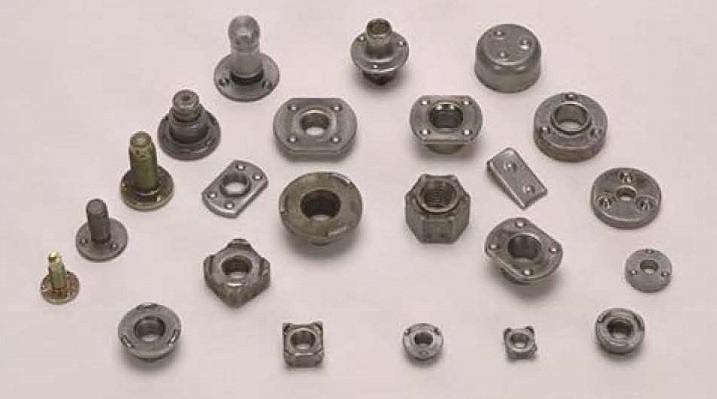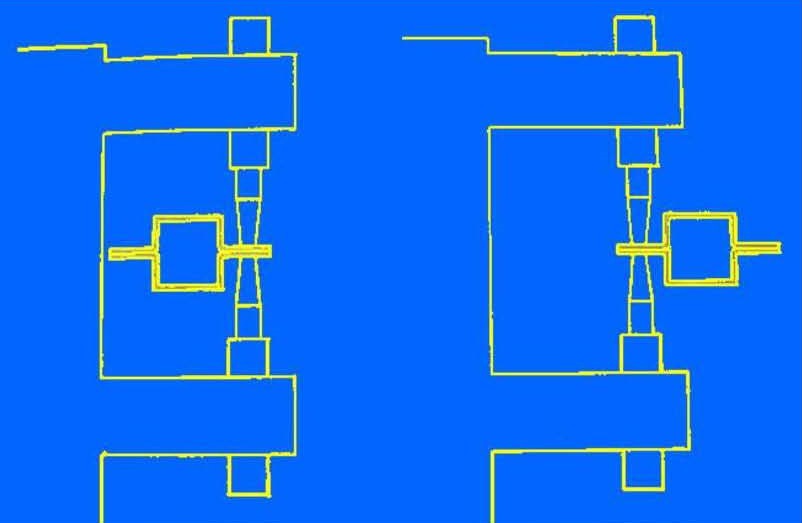
Spot Welding
Questions and Answers
You stated that all runs well but once in a while you have a bad push out on your nut welding. Apparently your weld schedule works and produces good welds but some variable is causing discrepancies occasionally. Let’s address the important factors in projection welding.
It is important that you have good equipment alignment so that you apply force to all projections on the nut at the same time and with equal force. Next the force system of your welder or gun must be able to move quickly as the projections collapse in order that full force is maintained. This is called fast follow up. A large press welder not properly equipped or a sticking cylinder or a slow servo could cause a problem.

FAST FOLLOW UP HOLDER
Projection consistency is important. Any variation in the projections on the nut will be an issue leading to inconsistencies. Nut feed consistency is imperative. If the feeder misplaces the nut it can lead to a momentary misalignment that squeeze time does not correct. Some projection welds are very fast with little or virtually no squeeze time. Though short some squeeze time may be necessary.

Projection Weld Nuts and Studs
If there an insulated locator pin. Is the insulation worn? Are there signs of arcing? The current could be shunting through the pin and bypassing the projections. Additionally it may be damaging the threads.
Is there a buildup of flash/residue that is interfering with alignment or causing a current/shunting path?
The fact that you have a working process most of the time indicates a variable is present that needs to be controlled. Other than a tweak the schedule is probably pretty close.
Additional helpful articles in this blog on this topic can be found in:
"WHY DO THE PROJECTION WELD PUSH OFF TESTS FAIL WHEN THE MATERIAL AND WELD NUTS HAVE NOT CHANGED?"
Reference schedules for nut and projection welding can be found in:
AWS Standard C1.1:2012 Recommended Practices for Resistance Welding
Ref: CMW Inc. Catalog
RWMA: Resistance Welding Manual, Section 3
AWS: Standard C1.1:2012 Recommended Practices for Resistance Welding
The fabrication of this equipment involves the integration of many systems including a frame, index table, tooling, automation; weld control, transformer and cooling.
This is the world of machine and system integrators and beyond the scope of this website.
Squeeze is the first of the three standard resistance weld sequences:
SQUEEZE
WELD
HOLD
The purpose of squeeze time is to allow the electrodes to close on the part and build up full pressure in order to contain the weld before the current initiates. Short squeeze time can lead to expulsion and the electrodes being damaged, running hot, inconsistent nuggets and erratic weld quality. Long squeeze time extends the total weld time and could mean fewer parts per shift. Selection of the proper squeeze time is important for the efficient production of quality parts.
Every welding machine or weld gun operates differently be it powered by pneumatic cylinders or servo. So no single rule can be set. One must determine at each weld station how long it takes for the electrodes to close and build up full force after the control initiates the squeeze sequence.
Tooling and fixtures are used in virtually all resistance welding operations to hold parts in place for welding. They must be kept clean of flash and debris and be safe for operators. Heat buildup should be minimized. If a fixture is heating up several possible reasons come to the forefront: Inductance, Insulation, weld flash and location.

BAD GOOD
This exhibits the part in the throat area but magnetic tooling in the throat causes the same problem. It absorbs energy and heats up during the welding process and forces the welder to work harder to make the desired spot weld.
To answer this question the first assumption is that the question is not concerned about a fixture or holding type clamp. The question is directed towards the electrodes on the welding gun or press welder that closes on the part and hold it in place to deliver the current and force and forge the weld. This answer will talk about the copper alloy used as the resistance welding electrode materials.
In other articles RWMA Group A Class 1, 2, 3, 4 are described. In addition RWMA Group B Class 20 is described. With the exception of the Class 4 all are used regularly as electrode materials in various applications. Their properties vary and it is their properties that decide their use in the various applications. The more conductive materials, Class 1 find applications where conductivity is most important. The stronger materials are applied where strength is the overriding factor, Class 3. Class 2 is used in most applications, which are steel. It is a middle of the road material with good conductivity and strength.
Page 28 of 44
Have a Question?
Do you have a question that is not covered in our knowledgebase? Do you have questions regarding the above article? Click here to ask the professor.
